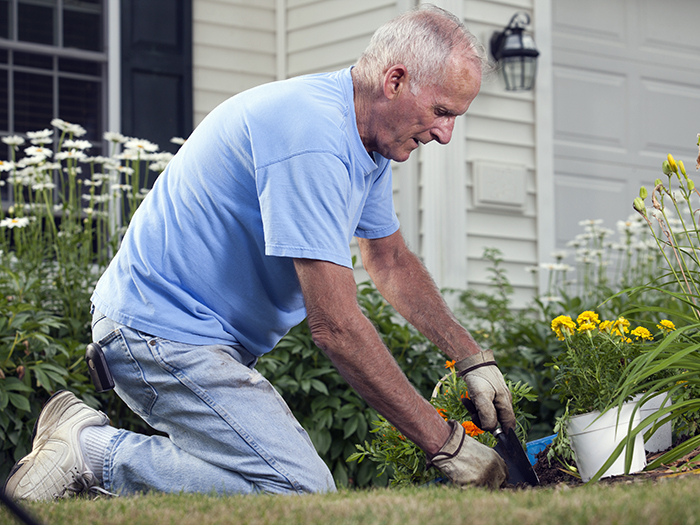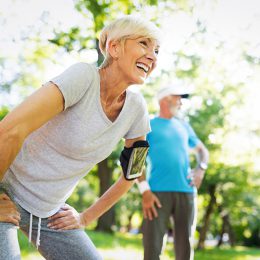The Workout That Can Help You Stay Independent Longer
Train your body to move better and free of pain for years to come with these five functional exercises.

If you want to move better and without pain for years to come, your exercise routine must be functional.
What exactly does that mean? Simply put, functional exercise is a workout method designed to mimic the types of movements you perform in everyday life. By training these movement patterns, you help build and maintain the strength needed to live independently. You’ll also minimize your risk for aches and pains that often compound with age.
“You always want to keep your goals and current or desired lifestyle in the back of your mind,” says Katherine Wilson, D.P.T., a physical therapist at the Hospital for Special Surgery in New York City. “Then, your exercises or daily routines should coincide with those goals.”
While functional exercise has a bigger emphasis on training movements as opposed to building muscles, it’s important to realize that any functional workout is truly a total-body one, says Eric Grossman, M.D., a physician at Rothman Orthopaedic Institute in New York City. The body functions best as a cohesive unit, rather than a series of parts, and functional exercise trains those parts to work together.
To get started with functional training, try performing the five-move routine below once per day. Each exercise is directly correlated with an everyday movement, so it’s easy to see the benefits.
How the Functional Workout Works
Start by doing one set of each exercise in order. As you get stronger—or on days you have more time—perform the full circuit up to three times, resting two minutes between rounds.
When it comes to functional fitness, consistency is the most important factor, Wilson says.
“The key to getting stronger and improving the quality of daily activities is frequency of activity,” she says. “If you dedicate a little time every day to it, you will see improvements.”
That means doing one round every day or most days is more beneficial than doing multiple rounds every once in a while.
Ready to get started? Here’s how to perform each movement. As always, safety is key. The exercises here may be different or more advanced than those you’ll experience in a SilverSneakers class. If you have a chronic condition, an injury, or balance issues, talk to your doctor about how you can exercise safely.
If seated exercises are best for you, check out this 15-minute total-body chair workout.
Functional Exercise #1: Deadlift or Hip Hinge
Helps with Everyday Movements Like Picking Things Up from the Floor
You’ve heard the advice to “lift with your legs, not your back.” This simple reminder can prevent potentially serious injuries, and mastering the deadlift with proper form allows you to do it even better.
“The deadlift strengthens your entire backside, which is home to your body’s biggest, strongest muscles,” Grossman says. “It also teaches your body to stabilize your core and spine for healthy back mechanics.”
But this isn’t a deadlift with a barbell or other heavy weight, which can be risky. The focus here is on using a lighter weight and proper form.
Do 10 to 12 reps
How to do it: Stand with your feet hip-width apart, and brace your core. Hold a dumbbell or kettlebell at one end with both hands in front of you.
From here, push your hips back, and bend your knees to lower your body toward the floor, not letting your knees cave in as you do so. Keeping your core engaged and chest lifted, let the weight gently touch or hover above the floor.
Pause, and continuing to keep your core engaged and chest lifted, push the floor away with your feet and drive your hips forward to stand up. That’s one rep. Do 10 to 12 reps.
Make it easier: As with any exercise, form is everything—but that’s especially true for the deadlift. If you have difficulty using proper form or have back or hip problems, skip the deadlift and perform a hip hinge instead.
Functional Exercise #2: Sit-to-Stand
Helps with Everyday Movements Like Getting Up from a Chair
Having a hard time standing up out of a deep, squishy couch is one thing, but trouble getting up and down off of everyday seats—like the toilet—can quickly limit your ability to stay independent. That’s why this basic exercise is so beneficial.
Do 8 to 10 reps
How to do it: Stand with your heels six inches in front of a chair or bench. Hold your arms out in front of you for balance as needed. Brace your core.
From here, bend your knees and hips to sit back until your glutes touch the chair. Pause, then push through your heels to return to standing. That’s one rep. Do eight to 10 reps.
Make it easier: Allow yourself to briefly sit and relax on the chair before standing back up, or use a higher bench so you don’t have to sit down as far. Make sure to stand up by pushing through your heels, rather than swinging or using momentum.
Functional Exercise #3: Floor-to-Stand
Helps with Everyday Movements Like Getting Down and Up from the Floor
This exercise is more important than you might think. Case in point: A European Journal of Preventive Cardiology study on more than 2,000 men and women ages 51 to 80 found the easier it was for people to get down and get back up from the floor, the lower their risk of early death from any cause.
This exercise tests and trains your body to work as a cohesive unit, leaving no muscle group unturned, Grossman explains.
Do 4 to 6 reps
How to do it: Make sure you have clear, safe floor space. Lower down to the floor and get back up however it’s safe for you. You can sit up, sweep a leg under, and stand up. Or you can gently roll to your side or stomach, and push up from there.
You can try different methods to see what works for you. Do four to six reps.
Subscribe to our newsletter
It's quick and easy. You could be one of the 13 million people who are eligible.
Already a member? Click to discover our 15,000+ participating locations.
Follow Us
Make it easier: Use as many contacts points—a wall, a couch, the floor—as you need to guide yourself. Plus, learn more about this what getting up and down from the floor means for longevity.
Functional Exercise #4: Farmer’s Carry
Helps with Everyday Movements like Carrying Groceries, Kids, Anything
Carry exercises are excellent for training the entire body, with a special emphasis on core stability and grip strength. Why grip strength matters: Research suggests it can more accurately predict the likelihood of fatal heart disease than blood pressure can.
Walk for 30 seconds
How to do it: Grab a pair of kettlebells or dumbbells, and let them hang naturally at arm’s length next to your sides, palms facing in. Walk forward for 30 seconds or as long as you can.
Keep an upright torso without allowing the weight to dump into your low back. Imagine a string is connected to the top of your head and pulling you toward the ceiling. When you feel your form slipping, squat down to safely place the weights on the floor.
Make it harder: If you can walk for longer than 60 seconds, try using a heavier weight.
Functional Exercise #5: Stepup
Helps with Everyday Movements like Taking the Stairs
Getting winded at the top of a flight of stairs actually has more to do with muscle strength than cardiovascular fitness. Strengthening your quads and glutes with single-leg exercises like the stepup can help you take them in stride, Grossman says. No elevators or escalators needed!
Do 6 to 8 reps
How to do it: Stand in front of a step. Start with a low step, increasing the height for a challenge. If you like, perform the move next to a wall for support.
Set your right foot on the step, push down through your heel, and lift yourself up until your leg is straight. Step up with your left foot, and then step down one foot at a time. That’s one rep. Perform six to eight reps or as many as you comfortably can.
Make it easier: Do all reps with one foot and then all reps on the other. If you feel any discomfort in your knee, choose a shorter step, and lean forward slightly as you perform the exercise.
Make it harder: Once you’ve mastered the bodyweight stepup, it’s time to add some resistance. Grab a pair of light dumbbells, and hold them at your sides with palms facing your body as you perform the movement.
Take Your Favorite SilverSneakers Classes Online!
SilverSneakers members can access live fitness classes and wellness workshops through SilverSneakers LIVE. See the latest schedule and RSVP for classes here.
Not a member? If you have a Medicare Plan, it may include SilverSneakers—at no additional cost. Check your eligibility instantly here.





